Like many big cities with a strong ‘crossroads’ element, Bangkok is a place where cultures, personalities, and histories merge into one big socio-economic stew. There exists almost unlimited opportunities to see things you’ve never heard about; experience things you’ve never thought of; and talk to people you never would have met otherwise. It’s a hell of an opportunity to learn some pretty cool stuff. At a recent lecture at the Siam Society, I met a gentleman named John Toomey, an American who is, ahem, steeped in the ancient and intricate tea ceremonies of Japan and Korea. He very graciously invited myself and a few others to his house to take part in a tea ceremony, and this is how it went down. A warning – if you don’t really dig tea or cultural nuance, this post might be a bit long for you.
Some background… my only memories of tea growing up are of my British Grandmother drinking about forty cups a day, which I found both amusing and slightly frightening. The next time I had any exposure to tea was when I was studying Ninjitsu in High School, and my sensei told us of having tea with his sensei. I laughed at first, because I always thought tea was for old ladies, but the fact that he could have broken every bone in my body with a slightly damp sponge persuaded me that there might be more to the story.
Anyway…
It was the ancient Chinese who started drinking tea, approximately eight million years ago. Well, not quite, but it goes back many, many centuries. The practice came to Japan in about 815AD and over the years developed into an intricate and multi-faceted ceremony governed by many layers of protocol and discipline. There are dozens (hundreds?) of different styles and types of tea ceremony, but all are meant to promote harmony and inner peace, and act as a venue for conversation and friendship.
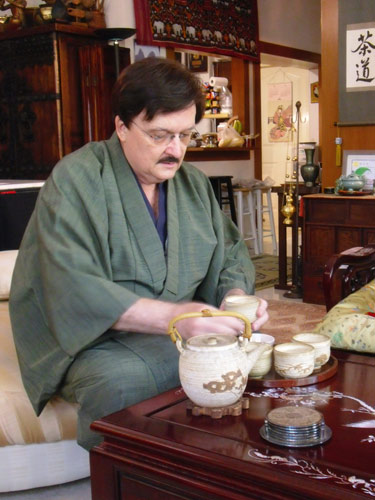
John preparing the first round of tea.
The day started when John, clad in a traditional kimono, served myself and the two other guests – Steve and Piyawee – a salty tea flavored with pickled cherry blossoms. This is so that guests – after traipsing across mountains and working up a sweat – can renew some of their body’s lost salt content. Next, we seated ourselves in John’s gorgeous garden sala (a type of gazebo) as he prepared the tea room. This acts like a tea ceremony movie trailer – guests are teased by the tranquil sound of gurgling water, but are unable to see the setting. At John’s instruction, we walked over a bridge from the outer garden to the inner garden – symbolizing the crossing from the hectic world outside to the tranquil inner sanctum.
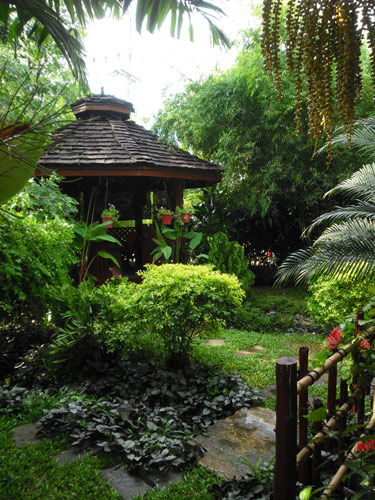
The garden and sala in the background. Great setting.
Next, guests wash their hands at a stone pot set in the ground. What I thought was really cool about this part is that the best view of the garden and waterfall is from this lowered position. Essentially, it’s only by being humble and modest that you can see the true beauty in the world.

Piyawee washing her hands before we enter the tea room. Only from this position do you get the best view in the garden. The fish on the right have a slightly less awesome view.
After entering the tea room, each guest should kneel in front of a scroll and some flowers, which set the mood of the day. In keeping with our tea earlier, it was a painting of cherry blossoms.

Guests kneel in front of this painting and study it to set the mood. I wonder what would happen if a Rorschach diagram was placed here?
John also gave us each a little kit with some basic tea supplies. We weren’t going in unprepared!

The kit that each guest uses. A fan (top), a small knife for cutting tea cakes, and paper napkins to place your cake on
After seating ourselves around an iron pot set into a hole in the floor, John proceeded to set everything up. This took some time, as he was explaining the meaning behind each gesture (every movement – from folding napkins to setting down utensils – is done in a certain way). John set up the charcoal fire (using special charcoal imported from Korea), set an incense stick nearby to cover the smell of smoke, laid out the instruments and set the pot of water over the embers. We then broke for lunch.

John lowering the pot over the fire. Note the basket of supplies to the left – charcoal, incense holder and an owl feather to dust!
Back in the tea room after eating, John prepared the tea. It was a good time, with light conversation and jokes, interspersed with info about the ceremony. John used powdered green tea, which he then added the boiling water to, and stirred it into a froth with an intricately carved bamboo whisk.
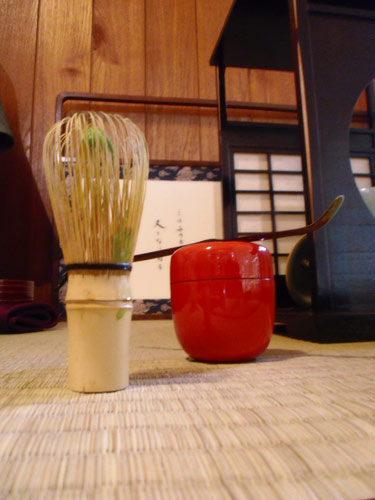
The whisk, on the left, and the tea container, made from Japanese lacquer. The whisk is made from a single piece of bamboo. Neat!
As I was the first to drink, I had to place the tea cup in between myself and the next person to drink (in this case, Steve), and bow to him to excuse myself for drinking before he did. Next, I had to bow to John to thank him for serving me. Lastly, I had to hold the cup in my left hand and rotate it 180 degrees with my right hand; this is to turn the front of the cup toward my host so that I – ever humble, remember – am drinking from the back.
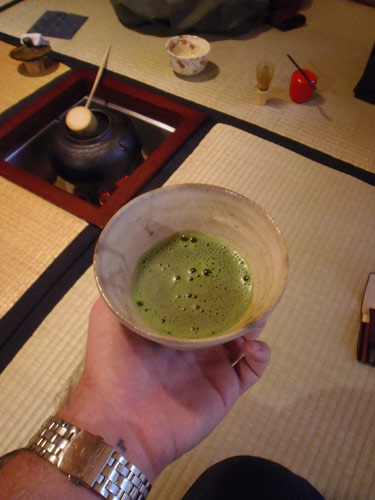
Like drinking anti-freeze, but less poisonous! An excellent cup of tea.
The tea was dark green and very good, with a strong, even taste and no bitterness. John was very thankful that I then invited him to partake, because the host is not supposed to imbibe without an invitation from one of his guests. Another round was whipped up and enjoyed, and then we called it a day.
If you’re interested in this type of thing, it’s well worth checking out; a tea ceremony is a pretty cool way to experience a unique facet of another culture. As far as I know, Thais aren’t… cultured enough to have their own version of this ceremony. However, I don’t believe they ever ran around disemboweling themselves because they made a minor social faux-pas, either, so I guess it all evens out in the end. Salut!

John’s beautiful garden. A dude could get some serious thinking done in a setting like this.


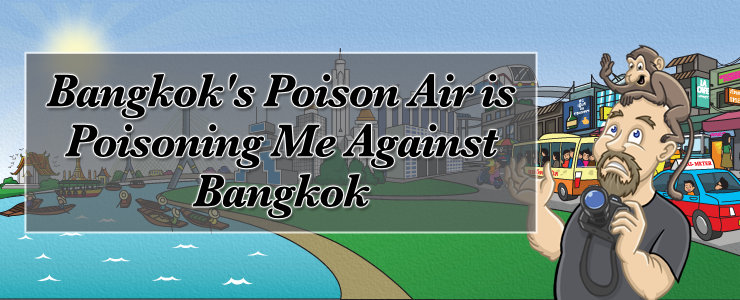
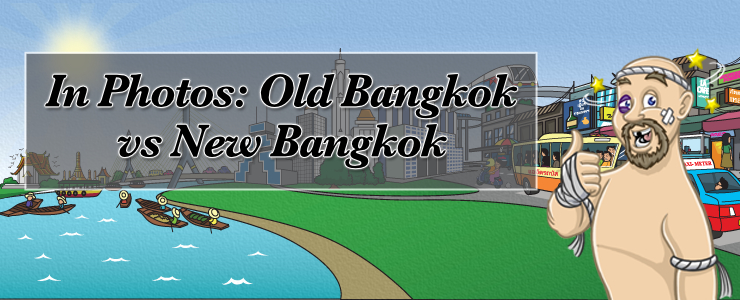

aw, you met Steve and Piyawee! They helped me out a lot with my research. 🙂
looks much better than a teabag…..uh Beavis he just said teabag.
This tea ceremoney looks highly intricate, incredibly charming, and very relaxing. A little wi-fi and twitter in the garden might make it perfect.
Interesting ceremoney, would like to do something like this sometime.